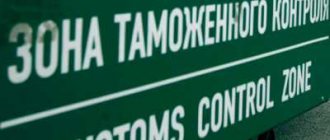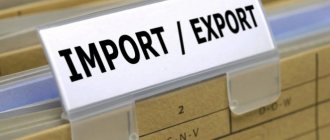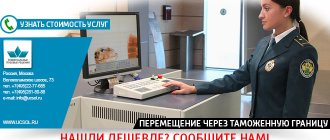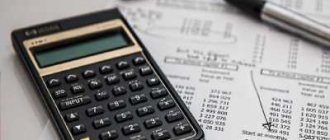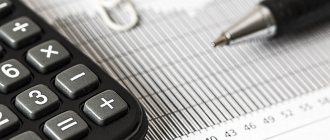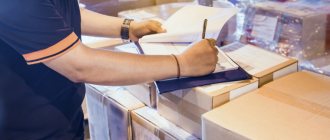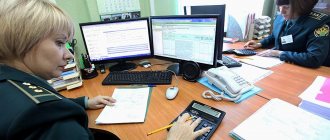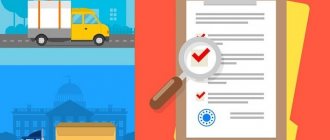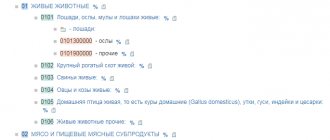Under the term customs value most often understand the customs value of goods (CTV). Based on its value, the customs payments required for payment are calculated, that is, duties, taxes, excise taxes and fees. Thus, the customs value is formed from the value of the goods and the amount of all expenses incurred by the participant in foreign economic activity during their transportation to the Russian Federation (i.e., expenses incurred on foreign territory). The customs value, that is, its value (size) is recorded in a special document - DTS-1, which is submitted along with the main customs declaration.
What is the concept of customs value? The customs value of imported goods is the value of the transaction with them, that is, the price actually paid or payable for these goods when they are sold for export to the customs territory of the Union…” (Article 39 of the EAEU Labor Code).
In other words, customs value is the sum of costs incurred by a participant in foreign economic activity (FEA) when purchasing goods, insuring them, licensing and delivering them. Also, when calculating the customs value, other possible expenses incurred by a participant in foreign economic activity when delivering goods from the place of purchase abroad to the border of the Customs Union are taken into account.
The customs value of goods (CTV) is determined by the formula:
TCT = purchase price + additional costs (transportation, insurance, licensing, customs brokerage services, etc.).
The EAEU Customs Code understands goods as any movable property, including electrical energy, goods transported through pipelines, currency, securities, traveler's checks, etc. (Article 2 of the EAEU Labor Code). Customs duties, taxes and fees accrued on the customs value and paid by participants in foreign trade activities during customs clearance of goods are state income and go to the country’s budget (it is known that customs payments account for up to 40% of the Russian budget revenue!).
What is KTS?
Adjustment of customs value is a recalculation by customs officers of the value of the goods, which the importer indicated in the documents, and which they are not satisfied with. Customs authorities make a decision on CTS if the declared value of goods imported into the Russian Federation is underestimated.
If the CTS is carried out, then its result will be additionally accrued taxes and duties, which the declarant will have to pay without fail.
KTS happens:
- Conditional. Includes additional customs inspection. The goods are released conditionally or with mandatory future payment.
- Final. The amount that customs has added to the additional customs payment is written off immediately.
Various customs duty accounting options
If the customs office considers that the customs value should be different from what you declared in the customs declaration, and you decide not to argue with it, then you will have to decide how to reflect the change in customs duties in accounting and tax accounting. And first of all, we need to look at how customs duties themselves are taken into account.
As is known, in tax accounting, customs duties can be taken into account both in the cost of goods and as part of other expenses. Your company can choose (or has already chosen) the accounting option independently and enshrine it in its accounting policy.
In accounting, customs payments (except for VAT, which is deductible) must be included in the cost of the goods. But this requirement is often not met. Importers are trying to bring their accounting up to tax compliance. For many (especially if there is no need to prepare reports according to international standards and undergo an audit), this is better than bringing tax accounting closer to accounting and depriving the opportunity of one-time recognition of customs duties in expenses, which is provided by the Tax Code. Such importers are guided by the requirement of rational accounting. After all, as a rule, documents from customs arrive with a significant delay, and it is often simply impossible to determine the reliable amount of duty at the time the goods are posted.
Who carries out the customs value adjustments?
The customs inspector can make a decision on adjusting the customs value and carry out the procedure. After declaring the goods and calculating its price by the importer, the inspector uses the program to compare the cost with the risk profile data.
Also, CCC can be initiated by the importer when he needs to make changes to documents.
Methods for determining customs value
Russian legislation defines six methods of customs value. If it is impossible to determine the price of the goods in the first way, customs moves to the second, etc.
- Based on the transaction value of imported goods. The costs incurred or to be obligatory paid for the purchase of goods, their delivery, insurance, license, agent commissions, etc. are taken into account.
- At the cost of a transaction with identical goods. The customs value is assessed in the same way as the value of identical goods that have already passed the border of the Russian Federation within 90 days.
- Based on the value of a transaction with similar goods. The procedure is similar to the previous method, but homogeneous products are taken into account, which have similar functions and characteristics, but they are not identical.
- Based on subtraction cost. The customs authority takes the cost of identical or similar goods that were sold in their original form on the territory of the Russian Federation.
- Based on cost addition. Production costs, profits and sales costs of declared products are taken into account.
- The reserve method involves expert assessments and special calculations, which are based on the selling price of these goods on the territory of the Russian Federation.
How to confirm the first method?
Confirmation of the first method of customs value involves the collection and correct execution of documents in order to prove the customs value originally indicated by the owner of the cargo in the declaration. In order to minimize the risk of the CTS, it is necessary to have all the documents necessary to confirm the price that you indicated in the declaration. Moreover, a package of documents must be “at hand”. Often, participants in foreign trade activities take the collection of documents lightly, and when customs requests additional documents, they simply do not have time to complete them.
What does the customs value of goods consist of?
Customs value is a price equal to the amount of costs incurred by a foreign trade participant when purchasing goods, insuring them, licensing, transportation, agent commissions, etc. This will include all expenses from the moment of purchase abroad until the moment of declaration.
Customs value = purchase price + additional costs.
How not to make mistakes when declaring customs value
Declaration is an important part of customs clearance. All imported and some exported goods must be declared. It is very important to correctly determine and reliably declare the customs value, since duties and taxes depend on it. Because of this, customs controls it especially carefully. Customs legislation is always subject to adjustments, but the main document that spells out the determination of customs value is the EAEU Customs Code.
Application of the first method
The first method of determining cost is the highest priority and is suitable for almost all cases. The transaction price of the goods is often taken as the customs value. The declarant must correctly indicate all expenses: transportation, insurance, commissions, etc. All expenses are documented. Otherwise, the customs inspector will have grounds to carry out the CTS procedure.
Actions in case of error in declaration
The importer may make mistakes during declaration and calculation of amounts. The customs value must be adjusted by the declarant if he notices the defect on his own. If the inspector finds an error and wants to send the value for adjustment, the declarant must send a letter indicating that the error is technical.
Checking the value after the goods are released
Customs has three years after the declaration is issued within which it can carry out customs value control. To identify incorrect data, customs can carefully check the declarant’s accounting, all banking transactions, and request data from the tax office. If customs finds a declaration with errors, the declarant will face administrative liability and will be required to pay additional taxes.
What is additional verification
If declared correctly, customs may additionally check the value. This situation occurs when one of the risk profiles is triggered, when the cost is less than indicated in the customs authority program data.
The declarant is sent a letter about additional verification and a calculation with the specified amount of customs duties that must be paid for release. If the amount is small, the importer often agrees with the adjustment and does not prepare a package of documents. The time frame for customs review of documents on the declared value and its acceptance is 60 days.
Why does the adjustment occur?
Representatives of the customs service have statistical data on the cost of a particular product by country and region. They have at their disposal price catalogs, documents on previously concluded transactions, stock quotes and indices. This data is accumulated for each HS code. The need to adjust the customs value arises when:
- The cost of imported goods is below the risk level.
- The cost of goods does not fit into the range of statistical data for a specific HS code.
- The calculation does not include brokerage, forwarding and other services.
- The product costs less than its individual components.
- The choice of method for calculating customs value is not justified.
- The information in the declaration does not correspond to the actual data.
- There are other circumstances that make it possible to doubt the reliability of the customs value.
Risk profiles are issued by the Federal Customs Service. These documents indicate risk factors, for example: statistical cost per kg, country of origin and dispatch of goods, and more. If, for example, the cost of goods per kg turns out to be lower than the statistical value, then the risk is triggered automatically, and customs must request additional documents from the declarant to confirm the customs value
There are situations when the contract stipulates a reduced value in order to save on customs duties. But there are also cases when adjusting the customs value is illegal. For example, the importer indicates the actual customs value: he simply managed to negotiate a lower price with the supplier, or the supplier provided a discount. Then you will need to document the customs value.
In general, the adjustment of customs value ensures conditions for fair competition, because if the customs value is underestimated, a smaller amount of customs duties is paid and thereby ensures a competitive advantage.
In principle, you always need to be prepared for adjustments, because the vehicle is valued using the price comparison method.
How to avoid CTS?
CTS has already become commonplace for foreign partners, brokers, customs officers and other participants in foreign trade activities. Usually everyone puts up with this procedure and considers it practically mandatory.
But if the cost of the goods is not underestimated and is stated correctly, then its adjustment violates the norms of current legislation. But the “Law on Customs Tariffs” clearly indicates the procedure for how to correctly determine the price of exported goods, methods and calculation algorithms. Often, customs officers use only the first and sixth methods, which need to be described in more detail.
The first method determines the value based on the transaction price. Most imported products must be identified in this way. But in practice, customs often refuse to use this method, justifying the refusal with various pretexts. And the majority of foreign trade participants cannot object to anything due to legal illiteracy.
Art. 14 of this law defines several cases when the declarant can use this method. To apply it, the declarant must prepare all the necessary documents that confirm the costs incurred by the declarant as a result of the acquisition.
This will include the costs of delivery to the Russian border, loading, unloading, packaging, agency fees, etc. A complete list of all documentation will help to avoid delays and adjustments.
If the customs authority nevertheless refuses to use the first method, then it must move on to the second. But difficulties arise here due to the fact that customs officers will have to study a lot of information. In addition to product prices, they study the terms, volume, and incoterms.
They will have to confirm that the information found corresponds to the case being processed. But the customs authority is unlikely to want to waste time searching for data. It turns out that customs officers will also refuse the third, fourth and fifth methods, formulating the refusal “Lack of necessary information.”
Either customs officers are simply lazy, not wanting to look into the database, or they deliberately try to bring the declarant to the CTS of his goods. But there is no way to check this.
If customs refuses to accept the declared price, then it recommends going straight to the sixth method - adjustment. Often everyone agrees with the price set by the customs authority. In this case, the declarant also violates the law. Namely, the calculation procedure.
Art. 24 clearly indicates that the sixth method is an extended second or third. But information on prices is taken not for a certain period, but for the whole year. But often customs officers calculate the cost based on the risk profile, and do not take price information into account.
But the law states that fictitious data cannot be used as value. Risk profiles exist, but inspectors need them as an indicator. But the latter offer such a price for imported products so as not to engage in deep calculations and avoid their direct responsibilities.
It turns out that CTS is carried out in violation of the law, and importers who do not prevent this are also violating the law. The management of the customs authority knows about this.
Other participants in foreign trade activities with such knowledge can significantly reduce the ability of customs to adjust the price of goods. But attempts by inspectors to carry out the adjustment procedure will not help at all.
You should not blindly agree to the proposal of the customs authorities for the CCC procedure and do it yourself. In this case, participants in foreign economic activity lose the opportunity to appeal to a higher authority or arbitration court. The importer should try to convince customs officials to use the first calculation method.
What documents does customs check?
The most important advice that can be given to a foreign trade participant is to collect as complete a package of documents as possible. This may include contracts between the supplier and the buyer, commercial offers and price lists of the supplier, export declaration, etc. (Please note: under no circumstances should you use a fake export declaration!). It is important to ensure that the export declaration is correct. At the first stage of delivery, it would be a good idea to play it safe and order price lists certified by the Chamber of Commerce and Industry of the country of departure. Good evidence will also be the availability of prices for a given product in open sources, for example, the manufacturer’s website, marketplace, and even the selling price on the importer’s website, with an attached price calculation, selling price for previous deliveries.
In practice, there have been cases of substitution of export declarations by Chinese suppliers - the latter provide the importer with a declaration with one data, code or price of the goods (especially attention is required when purchasing products through a trading company of a Chinese manufacturer in Hong Kong), and submit another to the customs authorities in order to refund VAT in increased volume. When the customs authorities request a declaration in the country of departure, it turns out that the data on the value of the goods in the two documents are different. Customs regards this as providing false information when declaring goods, which is a 100% basis for refusing a positive decision on accepting the declared customs value, as well as for carrying out additional measures to check a foreign trade participant for evasion of customs duties.
When making repeated deliveries of goods, after the cost of the first shipment has already been confirmed, the customs clearance process is simplified, but still requires full readiness to provide the required package of documents. The cost of subsequent shipments, with the competent approach of the declarant, is usually accepted without interim measures.
CTS procedure
The customs value is adjusted according to the following algorithm:
- Preparatory stage. Customs authorities conduct a more detailed check of all documentation of the goods. Customs value control is carried out.
- The customs officer looks for inaccuracies in the declaration, calculates the approximate customs value and security deposit.
- If the situation requires it, the customs authority requests additional documentation.
- At the end of the inspection, customs issues a verdict on the CTS. The customs authority must decipher the grounds for this procedure.
- According to the control procedure, the final calculation of all types of payments is made, the customs office calculates the amount for additional payment or refund.
Depending on the initiator of the inspection and adjustment, the CTS form is filled out by the importer’s representative or the customs inspector.
Challenging the CCC
The importer or his representative indicates the customs value of goods that are imported into Russia. Customs officers check the cost using a risk management system. There are three outcomes:
- Customs confirms the price of the goods;
- Makes adjustments;
- Skips products with subsequent adjustments.
Cases of adjustment of customs value occur when the customs authority does not believe the documents provided by the declarant. If at customs the cost of transported goods is increased, then importers have only one way out in this situation - to challenge the adjustment.
After the verdict on the adjustment is made, the declarant can, within three months, according to the Arbitration Procedure Code of the Russian Federation, appeal to the arbitration court with a complaint to challenge it. It must indicate:
- The body or person who made the decision;
- Details of the dispute document and the date of action;
- Violated rights and interests;
- Links to legal acts that the document contradicts;
- The requirement to declare the challenge illegal.
To justify the price of a product in court, you can attach an invoice, a contract, accounting documents in which it will be displayed, a certificate of origin or the manufacturer’s price list.
Customs by item
Vladimir Ivanovich, has the latest reduction in the duty-free threshold for the import of Internet parcels affected their volume and the dynamics of customs duties collected? What can you expect at the end of the year?
Vladimir Bulavin: It is too early to make forecasts for 2021. In 2021, after lowering the threshold from 1000 euros to 500 euros, customs duties increased as the number of “paid” parcels increased: from 56.8 thousand in 2021 to 234.1 thousand in 2021, that is, 5 times .
Payments reached 895.6 million rubles. This is 3 times more than a year earlier. At the same time, you need to understand that over 95% of all international postal items moved within the framework of online commerce are in the segment of 20 euros and below.
2021 also saw a decline in overall online commerce. If in 2021, according to Russian Post, there were 350 million parcels, then in 2019 - 340 million.
According to our calculations, as a result of lowering the threshold from January 1, 2020 to 200 euros, there should be a comparable increase in the total volume of customs duties. But this is an approximate estimate, because the “fragmentation” of parcels has begun in order to adjust their value to the new threshold.
How do customs officers determine whether a product in an online parcel is intended for personal use or for subsequent sale?
Vladimir Bulavin: Our customs procedures are mostly digitized. Therefore, we can easily look up the history of a particular recipient of Internet parcels - in what quantity they arrive to him, from where, what is the range of goods, and draw a conclusion whether the goods are ordered for personal use or whether this is a commercial batch.
But the story doesn't come up in every case?
Vladimir Bulavin: Of course, not in everyone. We use a risk-based approach. It applies to the administration of all product shipments, not just parcels in online commerce.
The risk-based approach is also applied to participants in foreign economic activity. We look at the number of cargo shipments moved over the past two years: how law-abiding this or that participant was in terms of compliance with customs legislation, whether questions arose to him and what kind. Based on the assessment results, participants in foreign economic activity are divided into sectors: with minimal, medium and high levels of risk.
At the end of 2021, we had 110 thousand declarants. Of these, 10.5 thousand fell into the low-risk category, and almost the same number fell into the high-risk category. All others are a sector with a medium level of risk.
The Federal Customs Service is close to starting the automatic exchange of information on the customs value of goods with their Chinese colleagues. When can he start?
Vladimir Bulavin: The issue of customs value remains the main “point of tension” between customs authorities and declarants. We have already done quite a lot to reduce the conflict potential in the customs sector: over the past 3 years, the number of claims from participants in foreign economic activity against the Federal Customs Service has decreased by almost 3 times. The number of legal disputes resolved in favor of customs increased from 39% to 54%. But it is precisely on the customs value that disagreements remain.
The legislator has not given an unambiguous approach to determining customs value, and this is a kind of loophole for unscrupulous businesses. Obtaining reliable data on customs value from our partners from the Chinese customs administration will help resolve this issue. There will be no disputes, since we will receive the customs value at which the goods were actually exported from China. Now we (and the courts, too, by the way), primarily focus on the invoice - the agreement under which the goods are exported. But this is an unreliable source of information about customs values.
We signed a basic protocol on the experimental exchange of information in mutual trade with our Chinese colleagues in 2007. Today, 4 checkpoints have been identified on the Russian-Chinese border (2 railway and 2 road: Zabaikalsk - Manzhouli and Pogranichny - Suifenhe), as well as groups of goods for which already this year, as an experiment, we will exchange information online about customs cost, quantity, weight, HS code. We will use the information received in the risk management system. This will make it possible to quickly identify and suppress cases of understatement of customs value and, as a consequence, non-payment of customs duties.
The issue is of fundamental importance for us, because it is directly related to filling the country’s budget.
What products are we talking about?
Vladimir Bulavin: At the first stage, exchange will be provided for goods with a high risk of providing false information.
How is Far Eastern customs adapting to the growing volumes of mutual trade between Russia and China?
Vladimir Bulavin: We implemented a “one window” project in the Far East and took on additional functions of Rosselkhoznadzor. But for now, however, only in terms of documentary checks. That is, if we need to attract specialists from other departments, we involve them. In the Far East, the most important problem is the discrepancy between the arrangement of our and Chinese checkpoints. Our Chinese colleagues have a much more powerful infrastructure.
How does the Federal Customs Service participate in the fight against the illegal export of round timber to China?
Vladimir Bulavin: I can guess what inspired this question. Recently there was criticism from the Accounts Chamber that we have almost entire trains with timber going past customs abroad. We do not yet have such data. We will work with the Accounts Chamber to clarify things.
The Federal Customs Service is developing a search engine that will monitor the entire customs declaration process and respond to suspicious transactions
The information systems of the Federal Customs Service and Russian Railways ensure full traceability of the movement of goods across the border. Moreover, the data of these information systems are legally significant. But, let’s say, there are transfer sheets between our and the Chinese railway companies. This document is certified by our customs inspector and contains the weight, container number and declaration number. Therefore, it is very easy to compare what is declared and what is moved.
For us, the formula is simple: if you cut it down legally, take it out legally. When a forest is submitted to customs for clearance, we have to go somewhere and get an answer whether it was cut down legally or not. And there are a number of nuances here. Now the legality of logging or the legality of the origin of the forest that we register is determined by declarations of transactions with timber. The declarant must provide in the declaration the entire chain of origin of the forest or timber products.
At the same time, these data must be present in the EGAIS Forest (state timber accounting information system - RG). Our issuing inspector makes a request to the system and receives confirmation whether these records are there or not.
In our opinion, this procedure is imperfect. Therefore, we proposed to Rosleskhoz to supplement the system with the information we receive: information about volumes, sender, nomenclature. This will allow more effective control of forest movement.
How is the accounting of goods that move within the framework of mutual trade with the EAEU countries organized? Are there problems there?
Vladimir Bulavin: To record goods moved within the framework of mutual trade with the EAEU countries, there are statistical forms. Suffice it to say that out of 150 thousand cases of administrative offenses initiated in 2021, almost a quarter (38 thousand) were initiated due to incorrect or untimely submission of such forms. Due to differences in VAT rates and excise tax rates, there are difficulties. For example, due to the fact that the excise tax on tobacco products and cigarettes in Belarus is one and a half times less than the excise tax in Russia, businesses are tempted to take advantage of this.
The margin per truck, according to our Belarusian colleagues, is huge. Hence the false transit, false export. It is no coincidence that a decision was made at the highest level to equip transit trucks that carry goods through Russian territory with navigation seals that would allow tracking the vehicle’s path.
We conducted a successful experiment with our Kazakh colleagues: we tested a domestic navigation seal. In general, it has proven itself positively: you can track where the car stopped, how much it deviated from the declared route when it arrived at the checkpoint. Now there is a corresponding government decree. We hope that by doing so we will be able to eliminate false transit.
Every year we receive information from our Kazakh colleagues that transit was closed on the territory of Kazakhstan without the arrival of the goods themselves. That is, the documents were brought, the transit was closed, but the vehicle did not leave Russian territory. But the trouble is that we receive this information late, and little can be done. This process must be stopped. All the necessary means to track transit are currently available.
Starting this year, Russian customs officers will begin to exchange data on the customs value of goods online with their Chinese colleagues.
To solve such problems, there is the format of OKTS - the joint board of customs services of the member states of the Customs Union. On this platform we have already managed to resolve many issues, and we continue to do so. In particular, we are developing a unified policy for creating risk management systems for determining cost indicators. We strive to ensure that the registration process in all EAEU countries is truly uniform.
Does the FCS exchange information with Ukrainian colleagues?
Vladimir Bulavin: Information exchange with colleagues in Ukraine is minimal. Although we receive answers to some of our requests.
Everyone who travels through automobile checkpoints is worried about queues. What are you doing to solve this problem?
Vladimir Bulavin: The problem of queues is related to the design capacity of the checkpoints. The solution is simple: we need new checkpoints with greater capacity and better technical equipment. If we talk about the technical component, then, for example, we included in the Development Strategy of the Customs Service until 2030 a project to create an intelligent checkpoint.
The information basis of such a checkpoint will be a single digital platform that will be used by all regulatory authorities. Plus, we plan to add all the information from our technical control equipment there: radiation monitoring, weight and dimensional measurements, reading vehicle license plates, queue dispatching. This means that if there are no risks for a particular consignment, then it will pass through the checkpoint without stopping.
We also gave our proposals for the technical reconstruction of 37 checkpoints on the most intense routes. First of all, this is, of course, Finland, Europe as a whole and, in certain areas, China. They were included in the national project “International Cooperation and Export”.
As for the movement of individuals, if instead of one lane you create two, the queue will go twice as fast. But it should be noted that the construction of checkpoints is not the functionality of customs.
Existing checkpoints already have several lanes, but often only one is operational. And because of this, there is a rather long line.
Vladimir Bulavin: Perhaps there are such facts, I won’t deny it. But, as a rule, the tourist influx occurs before the Christmas holidays, before the holidays, when there are many days off. We are aware of all these areas; at this time we are trying to increase the number of officials involved at the checkpoint.
The new development strategy of the Federal Customs Service until 2030 involves the creation of a high-tech customs office. What is it, in simple terms?
Vladimir Bulavin: To understand what we have laid out in the 2030 Strategy, I will briefly say what is happening now. First of all, this is the reform of customs clearance in general. Over the 25 years of the existence of Russian customs, the situation has developed in such a way that all customs clearance took place in private areas. At the same time, the customs posts themselves were located in private areas: there were about 670 such customs clearance places.
The influence of the owners of temporary storage warehouses on the customs clearance process was clearly disproportionate to official relations. Therefore, it was decided, firstly, to concentrate all customs clearance on state areas, and there will be only 16 such customs clearance places. That is, 16 electronic declaration centers. We started this process at the end of 2018. To date, 12 centers have been created. In 2021, we will create 4 more as part of electronic customs offices: in the Far East - in the city of Artem near Vladivostok, in the south - in Rostov-on-Don, in the northwest - in St. Petersburg, and also in Moscow.
Thus, almost the entire declaration array will be processed at electronic declaration centers.
Violators often hide valuables, such as expensive watches, in cans. Photo: Sergey Kuksin/RG
What can be said about the results of the work of those electronic declaration centers that are already operating?
Vladimir Bulavin: Firstly, the level of controllability of the customs clearance process has significantly increased. Secondly, it was possible to resolve the problem when homogeneous goods were processed differently in different customs authorities. We have reached uniformity in customs clearance. Thirdly, the independence of our officials in making decisions on certain declarations has increased. That is, we broke off personal contact between declarants and our issuing inspector and thereby significantly reduced corruption risks.
According to our assessment, where electronic declaration centers operated during the year, customs duties increased, which, in fact, was one of the main goals of all the changes. This is the basis from which we are moving to a new strategy for the development of the customs service.
By the way, the transition to a new customs clearance system made it possible to automate customs procedures. In 2021, more than half of the entire declaration array was automatically registered - more than 2.8 million declarations (in 2021 - more than 1.8 million), more than 643 thousand declarations were automatically issued (in 2021 - about 324 thousand declarations).
Automatic registration takes 2 minutes, and automatic release takes an average of another 3 minutes. Thus, in general, it takes no more than 5 minutes to process risk-free shipments. All this without human intervention, quickly, but most importantly - objectively. We will continue to improve this process.
Saturation of the customs environment with digital will certainly lead to greater transparency in the customs sector and greater trust. And not only between customs and declarants, but towards greater trust between customs administrations of different countries of the world.
I think that in the field of international cooperation we are moving towards a one-time customs control and recognition of the results of this control by all customs administrations through which this or that product will be moved. This approach, in my opinion, is inevitable.
What is needed for such a system to work?
Vladimir Bulavin: Using open resources, we can already track the movement of a particular container. Where it was loaded, what it was loaded with, how long it took to get to Europe, where it was reloaded in Europe, where it was delayed, where there could have been unauthorized openings... More trust is needed between the customs administrations of different countries.
As an experiment, we have already developed significant material on recognizing the results of customs control with our Chinese and Finnish colleagues. In 2021, road maps were signed on the mutual recognition of authorized economic operators with South Korea, China, and Turkey (the status of an authorized operator gives the organization the opportunity to use a simplified procedure for processing cargo when crossing state borders. - Ed.).
True, we don’t have many authorized economic operators yet, but we believe that the transition to online assessment of consignments (currently consignments are assessed depending on the level of risk of the participant in foreign economic activity. All consignments of authorized economic operators automatically fall into the low category risk. - Ed.) will be an additional incentive for many declarants to obtain the status of an authorized economic operator.
When creating smart digital customs, do you take into account the risk that the electronics may fail?
Vladimir Bulavin: Of course. Divisions of the Federal Customs Service of Russia have been tasked with working out algorithms in case of failure, so that everyone knows what to do and how to behave.
The question is really serious. When there were about 700 customs clearance places distributed throughout the country and one, due to some circumstances, failed, then all the others continued to work. If we concentrate everything in 16 electronic declaration centers, then it is necessary to increase the stability of information systems by almost 50 times.
There is only one way out. We need “mirror copies” of all information systems that allow restarting in case of failure. We have them.
Over the past two years, we have managed to significantly reduce the number of emergency situations (information system failures). All of them, by the way, are recorded in electronic declarations. That is, if the declaration is being processed and there is a failure in the information systems, a note about this is automatically placed in it. This allows you to keep statistics of system failures.
In December 2021, for example, it was possible to reduce the number of such declarations nationwide to just six—hundreds of times lower than in previous years.
We have started construction of a data center in Tver. The planned launch date is the end of 2023. For now we are using what we have. As part of the national project “Digital Economy”, we will be allocated space at Rostelecom to store “mirror copies” of our systems there.
Please tell us about the interim results of the experiment with electronic Tax Free.
Vladimir Bulavin: The process is not yet 100 percent electronic, because a paper check is also issued along with the electronic check, but in the second half of 2021 it is planned to use all resources to convert this system completely into electronic form.
A regulatory framework has already been developed for this system. In general, since the start of the project to introduce the Tax Free system, over 100 thousand checks have already been issued. Trade turnover (according to the Russian Ministry of Industry and Trade) amounted to about 17 billion rubles, about 1.9 billion rubles were returned to tourists.
You mentioned that the Chinese have more modern checkpoints than ours. Tell us how the salaries of Chinese and Russian customs officers compare?
Vladimir Bulavin: We have three categories of workers. There are officials who are in the federal public civil service - there are 34 thousand of them. Another 14 thousand people are employees of the customs service, that is, “under uniform.” All others belong to the third category - workers. The total number is about 61 thousand people.
Regarding almost 12 thousand federal civil servants who work at checkpoints and as part of mobile groups, a decision was made to transfer them to the customs service. We have prepared the corresponding government resolution, it is being approved. Thus, we will have 26 thousand employees “under uniform”, 22 thousand in the federal public civil service and the rest - employees.
The average salary of civil servants is about 38 thousand rubles. Employees have about 57 thousand rubles. If we compare Chinese customs officials and our customs officials, the salaries are approximately the same. If we take our officials in the federal civil service, in China in similar positions, wages (taking into account compensation payments and bonuses) will be on average 20-25% higher.
However, we will have changes. We have reassessed the functionality of our issuing inspectors: during the day, such an employee performs several dozen legally significant actions for which he bears serious responsibility. Keeping him on a salary of 38 thousand rubles is not very reasonable. Therefore, a decision was made to raise the salaries of releasing inspectors first. This is already being done at the expense of our material incentive fund.
If you try to compare the Federal Customs Service with the customs administrations of other countries, where will ours be?
Vladimir Bulavin: We maintain contacts with more than 100 customs administrations around the world. We have basic agreements with 71 administrations on interaction and assistance in the customs field. And now we have our own representative offices or representatives in 21 countries. Therefore, we monitor all international experience in organizing customs affairs and are fluent in it. I can say that in our understanding of the current state of affairs, the Russian customs service looks quite decent.
At one of the forums there was a panel discussion moderated by a business representative. As an experiment, he organized an interactive vote to evaluate the activities of the country's customs authorities. The participants, to our satisfaction, came to the conclusion that the Federal Customs Service is somewhere in the top twenty leaders.
Details
Every day, customs officers encounter amazing things when, under the guise of some goods, they try to smuggle others or even move something secretly. What case from your practice struck you the most?
Vladimir Bulavin: You can amaze either with volumes or with some kind of exotica. In terms of volumes: we have one fairly wealthy person who sent his family abroad. So, by the time they returned, we received quite detailed information from our German colleagues about what was purchased there and in what quantities. Therefore, customs payments alone amounted to over 50 million rubles.
One of the most exotic episodes was when they tried to move a pair of Amur tigers across the border.
Do they often try to smuggle drugs?
Vladimir Bulavin: Drugs are a rather sensitive topic. In 2021, we seized almost 12.5 tons of various substances. This is half of all drugs that are used as evidence in all criminal cases initiated by all law enforcement agencies in the country. Large quantities of Moroccan hashish, Latin American cocaine, and Afghan heroin were seized. All this is moved in industrial secret places: in the cavities of containers, in gas tanks with a double bottom. Violators can be extremely inventive.
The smugglers tried to smuggle cartridges in a rolling pin, coins in a candle, and a ring in a children's cube Photo: Sergey Kuksin/RG
Important question
Vladimir Ivanovich, you said that the measures taken to combat corruption are not enough. What others are required?
Vladimir Bulavin: We need such structural transformations that will not allow a person to commit any corrupt acts. I would like to note that we consistently pursue a policy of building “contactless” relationships with businesses.
We have already talked about the digital saturation of the customs sector. Even the current level of development of such technologies makes it possible to identify both unlawful actions of the declarant and unlawful actions of customs officials. That is, all these actions already leave their electronic trace. It is important that it is identified in a timely manner.
We have an operational monitoring center - we plan to significantly enlarge it in the next two years. It will become an independent structure within the central apparatus and will provide all functional and main management. It will have built-in search engines that will allow us to see the entire customs declaration process and respond to any suspicious transactions.
Finance
What is the forecast for the transfer of funds from the Federal Customs Service to the budget in 2020 and what task were you given?
Vladimir Bulavin: So far, the forecast target for 2020 is 5 trillion 343 billion rubles. This is slightly less than in 2019, because the export component of transfers decreases annually due to the tax maneuver.
In 2021, the amount of federal budget revenue from customs and other payments amounted to 5 trillion 729 billion rubles. We exceeded the control target by 1.6%.
